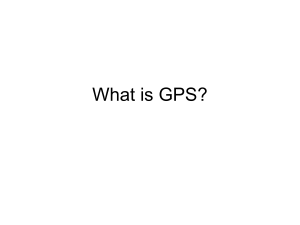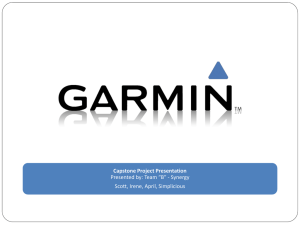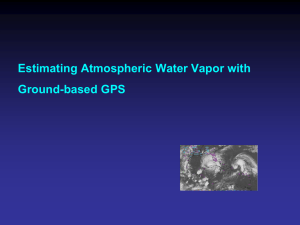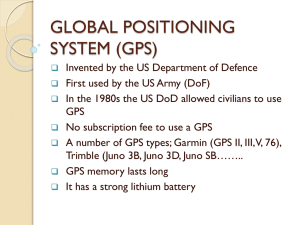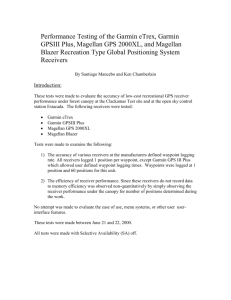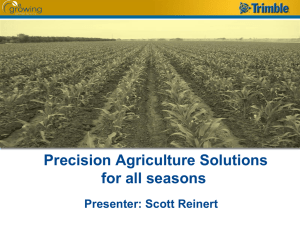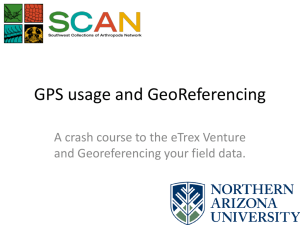Trimble
advertisement
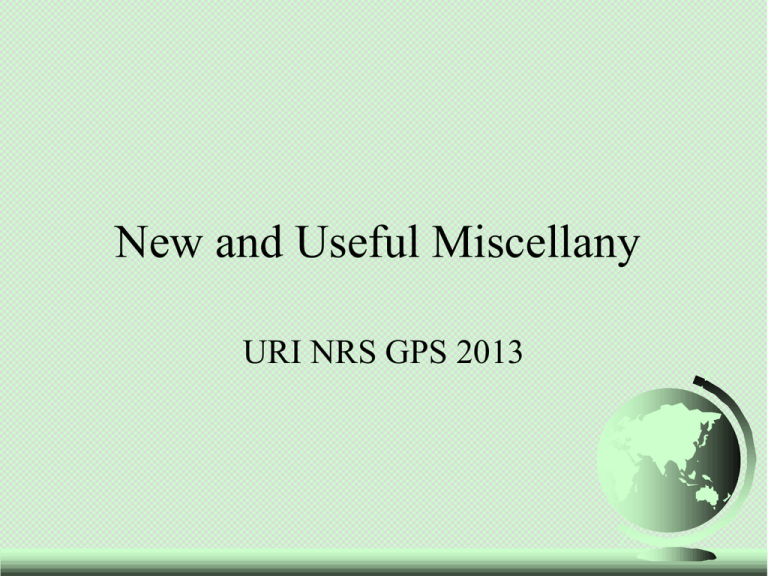
New and Useful Miscellany URI NRS GPS 2013 Two Scenarios When Differential Correction Lowers Accuracy 1. 2. This can happen when the base station is too far away - a long baseline. Know & record the base station you are using and how far away it is from the field site, especially if doing real time non-WAAS. TS, ArcPad and similar GPS software will simply locate the best available base station and use it - regardless of the specs in your SOP. While it is generally helpful to have this done automatically, always check on the distance to that software-selected base station and make sure that baseline distance meets the project requirements. Some non-CORS base stations do not keep NAD83 epochs up to date. An epoch is the mean date of the observations used in the regional adjustments to the datum. Official GPS time is not adjusted and therefore it is offset from UTC by a number of seconds due to the insertion of ‘leap seconds’. The number then remains constant until the next leap second occurs. This offset is also given in the navigation message and your receiver should apply the correction automatically. Recently GPS time was ahead of UTC* time by 15 seconds. CORS base stations are similarly updated, but non-CORS bas stations sometimes fall behind. If you use a non-CORS base station be sure to check on what epoch it is using. *UTC = Universal Coordinated Time, the proper name for what is commonly known as Greenwich Mean Time. NDGPS (National Differential GPS) Accuracy is reliable and improving for realtime (broadcast) code level diff corr. • CG maintains the whole system and has upgraded all coastal stations with Recap (new receivers and antennas). • DOT requested funding for interior as well – funded for this year (CG does the actual work). • NOTE: if using NDGPS real time diff corr in ArcPad remember that the NDGPS base stations are all on NAD83, so make sure you are using NAD83 for ArcPad’s datum frame on the rover. (otherwise ArcPad/Rover assumes incoming base data is in WGS84 and will shift @1.5 m - in New England) NDGPS upgrades do Not include High Accuracy broadcasts, which is something we’d hoped for. HA would be broadcasting carrier level corrections as well as code level corrections. It would be possible to broadcast L2C and L5 (new code frequencies), carrier phase corrections, plus corrections for Galileo (European) and Glonoss (Russian/Indian) as well as regular old code corrections. A few HA NDGPS stations are broadcasting for testing purposes in Maryland and one coming soon to Pueblo, CO. Tim is testing the one in Pueblo. High Accuracy Post Processing Right now Tim gets 8 cm accuracy with HStar diff corr on a GeoXH. HStar is a carrier code diff corr (dual frequency carrier code, post processed). This is signal is available from CORS stations but only for post processing, nothing real time. International News Chinese are building Compass GPS for global coverage similar to GPS. Aka Beidou-2. In a race with Galileo for first use/first rights to specific frequencies Interplanetary News The 2012 Solar Max is on the downswing and will continue to have effects on all things space-based, such as GPS or WAAS. Briefly, the intensity of solar winds (charged particles from the sun) swings from high to low over a 22 year cycle. The solar max is the peak of this cycle for its effect on earth. The unusually large number of charged solar particles inside the earth’s magnetosphere can cause unusually large atmospheric disruptions which could affect GPS signals, heighten aurouras (and possibly affect the electrical grid). This underscores the importance of doing proper differential correction whether post-processed or real time. Why? Because diff corr mostly serves to correct atmospheric attenuation of the GPS signals, such as those caused by the solar max. ArcGIS Mobile • • • • Set up GPS data collection for people with minimal training Real time only Simple preset data collection and field inspection Centralized management and configuration of projects Fizzy Calc • Converts between dd, dm and dms • Calculates between waypoints and projecting from a waypt from original one • A single executable file you can run from a usb drive – no install • http://www.fizzymagic.net/Geocaching/FizzyCalc/FizzyCalc.exe • What a GPS Mapping Receiver should do Hardware – Accuracy (How close to Truth) • Meet National Mapping Accuracy Standards: – 1:63,360 (32meters) – 1:24,000 (12 meters) – 1:5,000 (4 meters) – – – – – Reliability Rugged Able to Average a Point External Antenna options Good on Batteries • What a GPS Mapping Receiver should do Software – Export in GIS Friendly Formats – Capable of Controlling Attributes in the Field • Data Dictionary (Name, Trail Width, Comments) – Capable of Datum Transform – Mission Planning • Sky Plots • Planning the day – Run on standard PC / equipment Recreational Grade GPS - (e.g. Garmin) • Features Include: – Wide Use – Accuracy: • Autonomous < 15meters 95% typical • DGPS ready 3-5 meters 95% typical – User Friendly – Many models Garmin • Garmin GPSIII+, GPSMap76, eTrex – Moving Base Maps (1:100,000 scale) – Free software designed to allow download and upload of waypoints, tracks and routes from the Garmin to a PC Mapping Grade GPS - (e.g. Trimble) • Features Include: – Wide Use – Accuracy: • Autonomous < 15meters 95% typical • Post-Process DGPS – 3-5 meters 95% typical (Geo3) – 1 meter 95% typical (ProXR) – Pathfinder Office Software • Data Dictionary, Planning – Complex Feature mapping (pt/ln/poly) - Attributes - Waypoints Trimble GPS for GIS - Pros and Cons • Garmin III+ – Pros • • • • • Cheap and consistent 15 meters positions - good under canopy Good “Point tool” Fun and easy to use Integration into ArcView - relatively straightforward Battery usage is great – Cons • • • • • Cheap Position accuracy not so trustworthy Not designed for GIS Mapping - relies on 3rd party software No Data Dictionary capability Decent storage of tracks/waypoints (6-10 hours) GPS for GIS - Pros and Cons • Trimble GeoExplorer 3 – Pros • • • • • 1-5 meter mapping tool Point/Line/Poly Rugged Collects for 16 hours Software is excellent – Cons • • • • • Cost Firmware will be changing? Under-canopy issues - external antenna recommended Relatively small storage of tracks/waypoints(999) Need to post-process for best results (internet connection) GPS for GIS - Pros and Cons • Trimble Pro XR – Pros • • • • • • Top-of-the-line GIS Mapping Tool Real-time DGPS Point/Line/Poly Good under Canopy Rugged Software is excellent – Cons • • • • $10,000 Big/Bulky Firmware will be changing? Training involved Right Tool for the Right Job • Sorry… It’s a Multi - Tool Environment – Garmin – PLGR – Trimble • Need to learn enough about each system to know when to use the tool – – – – – Mapping a trash can lid? - ProXR Mapping a ATV trail - Garmin, Geo3 or ProXR Mapping sheep from the air? - Garmin\PLGR Mapping complex attributes? - Geo3 or ProXR In Dense Canopy - PLGR / ProXR Ideal GPS Toolkits • Garmin for navigation, point collection – Use DGPS system only if working along Gulf of Alaska, Southeast, out on the water • For Serious GIS – Trimble Geo3 for open country mapping – Trimble Pro XR for hostile environment (woods, city, lots of topography). What is Best? • Ask Yourself • 1) What are your accuracy needs? – A) resolution of the other data types – B) anticipated data for the future • 2) Project Needs – A) What are your GIS skills – B) Is it just you dealing with the data • 3) What part of the world are you working in? • 4) How much money do you have? Vertical Data (elevations) The football of accuracy Note Geoid 12a is current (2013) – don’t use Geoid 09 or 12! Do not switch geoids in the middle of a job or comparing datasets. In PFO, check the coodinates tab in the Export Utility and browse the Geoid choices under Mean Sea Level/ Other Geoid choices to select the right one (Alaska, Hawaii, CONUS). Always check Geoid settings including units settings (options/units) in PFO and standardize units for all distance, area and precisions measures. When you export data the “inf” file will have the Geoid information. Use it for your metadata! Take a Coordinate to Court Basic GPS use for NPS Rangers: Initialize Average Points Use an antenna Know thy datum and write it down Use differential correction Store the data electronically from the moment it is collected – do NOT write it down. Accuracy Aids David Wilson’s GPS Accuracy Page: http://users.erols.com/dlwilson/gps.htm The Alaska Way (hand-outs) Update GPS devices to local time - Keeps you square with filenames, photolinking, etc. Batteries- check ‘em and charge ‘em! SOP from pre-field prep through fieldwork, post processing and export to make good shapefiles and metadata Groundhog Mapping model ddf GPS myths dispelled The Alaska Way

